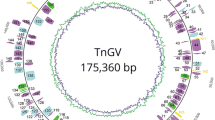Abstract
Spinosyns A and D are the active ingredients in a family of insect control agents produced by fermentation of Saccharopolyspora spinosa. Spinosyns are 21–carbon tetracyclic lactones to which are attached two deoxysugars. Most of the genes involved in spinosyn biosynthesis are clustered in an 74 kb region of the S. spinosa genome. This region has been characterized by DNA sequence analysis and by targeted gene disruptions. The spinosyn biosynthetic gene cluster contains five large genes encoding a type I polyketide synthase, and 14 genes involved in modification of the macrolactone, or in the synthesis, modification and attachment of the deoxysugars. Four genes required for rhamnose biosynthesis (two of which are also required for forosamine biosynthesis) are not present in the cluster. A pathway for the biosynthesis of spinosyns is proposed.
Similar content being viewed by others
References
Baltz RH (1998) Genetic manipulation of antibiotic-producing Streptomyces. Trend Microbiol. 6: 76–83
Bate N, Butler AR, Gandecha AR & Cundliffe E (1999) Multiple regulatory genes in the tylosin biosynthetic cluster of Streptomyces fradiae. Chem. Biol. 6: 617–624
Crouse GD & Sparks TC (1998) Naturally derived materials as products and leads for insect control. Revs. Tox. 2: 130–146
DeAmicis CV, Dripps JE, Hatton CJ & Karr LL (1997) Physical and biological properties of the spinosyns: Novel macrolide pest control agents from fermentation. In: Photochemical for Pest Control (PA Hedin, R Hollingworth, EP Masler, J Miyamoto and D Thompson eds) pp. 144–154. American Chemical Society, Washington D.C.
Dittrich H & Kutchan T M (1991) Molecular cloning, expression, and induction of berberine bridge enzyme, an enzyme essential to the formation of benzophenanthridine alkaloids in the response of plants to pathogenic attack. Proc. Natl. Acad. Sci. USA 88: 9996–9973
Ito S & Hirata Y (1972) Ikarugamycin II. Structure of ikarugamycin. Tetrahedron Lett. 12: 1185–1188
Jakobi M, Winkelman G, Kaiser D, Kempter C, Jung G, Berg G & Bahl H (1996) Maltophilin: a new antifungal compound produced by Srenotrophomonas maltophilia R3089. J. Antibiot. 49: 1101–1104
Kirst HA, Michel KH, Martin JW, Creemer LC, Chio EH, Yao RC, Nakatsukasa WM, Boeck LD, Occolowitz JL, Paschal JW, Deeter JB, Jones ND & Thompson GD (1991) A83543A-D, unique fermentation-derived tetracyclic macrolides. Tetrahedron Lett. 32: 4839–4842
Kirst HA, Michel KH, Mynderse JS, Chio EH, Yao RC, Nakatsukasa WM, Boeck LD, Occolowitz JL, Paschal JW, Deeter JB & Thompson GD (1992) Discovery, isolation, and structure elucidation of a family of structurally unique, fermentation-derived tetracyclic macrolides. In: Baker DR., Fenyes JG & Steffens JJ (Eds) Synthesis and Chemistry of Agrochemicals III (pp 214–225) American Chemical Society, Washington, DC
Matsushima P & Baltz RH (1994) Transformation of Saccharopolyspora spinosa protoplasts with plasmid DNA modified in vitro to avoid host restriction. Microbiology 140: 139–143
Matsushima P, Broughton MC, Turner JR & Baltz RH (1994) Conjugal transfer of cosmid DNA from Escherichia coli to Saccharopolyspora spinosa: effects of chromosomal insertions on macrolide production. Gene 146: 39–45
Mertz FP & Yao RC (1990) Saccharopolyspora spinosa sp. nov. isolated from soil collected in a sugar mill rum still. Int. J. Syst. Bacteriol. 40: 34–39
Myers RS & Stahl FW (1994) Chi and the RecBCD enzyme of Escherichia coli. Ann. Rev. Genet. 28: 49–70
Sparks TC, Thompson GD, Kirst HA, Hertlein MB, Larson LL, Worden TV & Thibault ST (1998) Biological activity of the spinosyns, new fermentation derived insect control agents on tobacco budworm (Lepidoptera: Noctuidae) larvae. J. Econ. Entomol. 91: 177–1283
Sparks TC, Thompson GD, Kirst HA, Hertlein MB, Mynderse JS, Turner JR & Worden TV (1999) Fermentation-derived insect control agents: The spinosyns. In: Biopesticides: Use and Delivery (FR Hall and JJ Menn, eds), pp. 171–188. Humana Press, Totowa, NJ
Strobel RJ & Nakatsukasa WM (1993) Response surface methods for optimizing Saccharopolyspora spinosa, a novel macrolide producer. J. Ind. Microbiol. 11: 121–127
Trefzer A, Salas JA & Bechthold A (1999) Genes and enzymes involved in deoxysugar biosynthesis in bacteria. Nat. Prod. Rep. 16: 283–299
Waldron C, Matsushima P. Rosteck PR Jr, Broughton MC, Turner J, Madduri K, Crawford KP, Merlo DJ & Baltz RH (2001) Cloning and analysis of the spinosad biosynthetic gene cluster of Saccharopolyspora spinosa. Chem & Biol (submitted)
Author information
Authors and Affiliations
Rights and permissions
About this article
Cite this article
Waldron, C., Madduri, K., Crawford, K. et al. A cluster of genes for the biosynthesis of spinosyns, novel macrolide insect control agents produced by Saccharopolyspora spinosa . Antonie Van Leeuwenhoek 78, 385–390 (2000). https://doi.org/10.1023/A:1010289901631
Issue Date:
DOI: https://doi.org/10.1023/A:1010289901631




